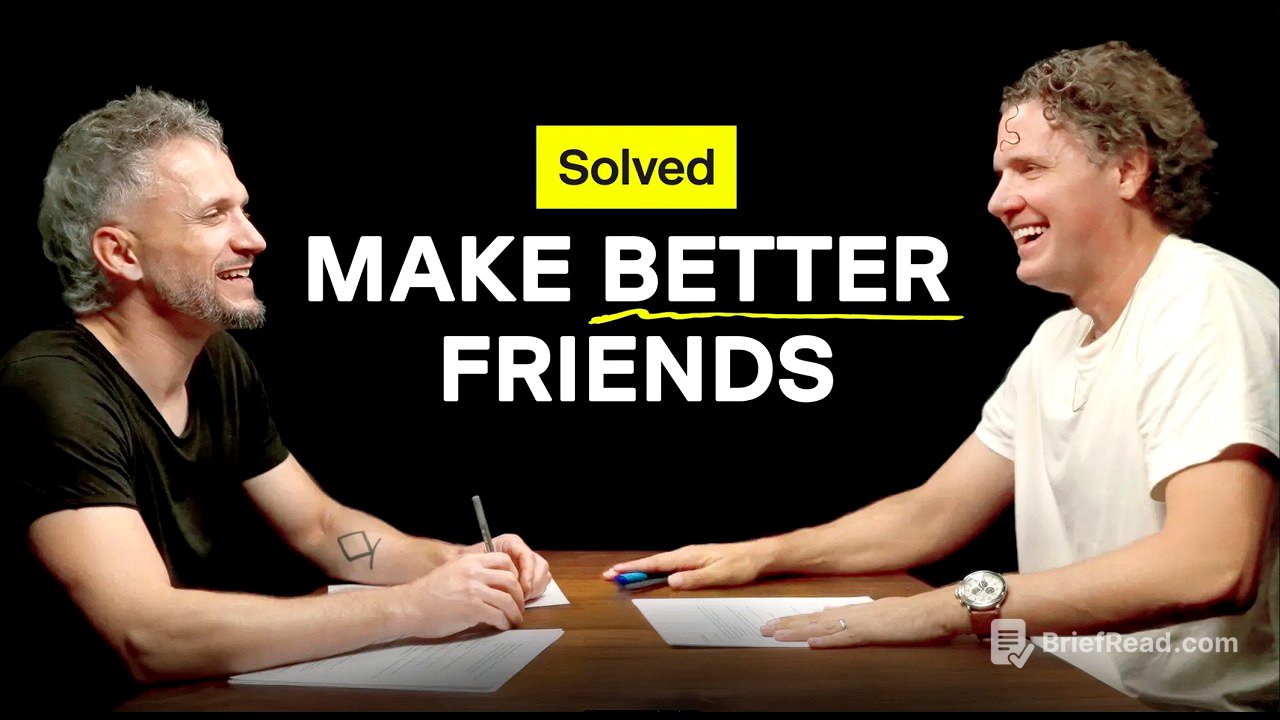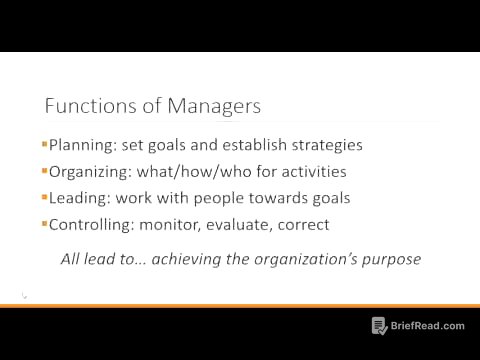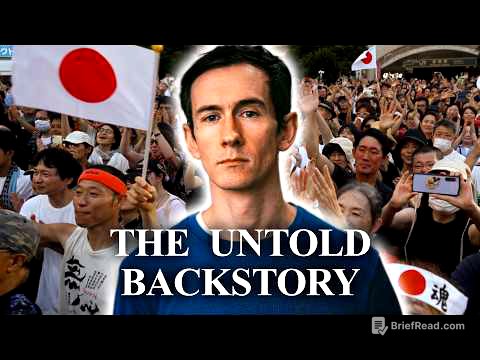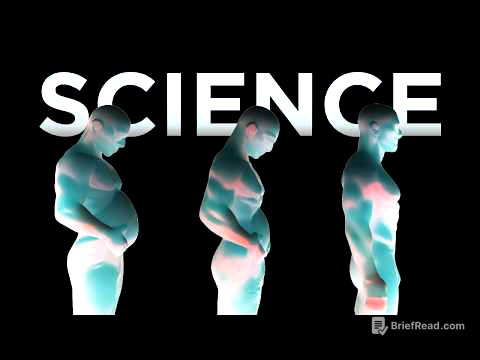TLDR;
This episode of the Dissolve Podcast explores the science, history, and practical aspects of friendship. It addresses the evolutionary basis of friendship, defines different types of friendships, examines the neurobiology and health benefits of social connections, and provides strategies for building and maintaining meaningful relationships. The podcast also discusses modern challenges to friendship, such as technology and societal changes, and offers advice on navigating toxic friendships and improving one's social life.
- Friendship is an evolutionary adaptation, essential for survival and well-being.
- Modern challenges like technology and societal shifts impact our ability to form and maintain friendships.
- Nurturing existing connections and being proactive in social interactions are key to a fulfilling social life.
Introduction [0:00]
Mark Manson and Drew Bernie introduce the podcast episode about friendship, a topic they believe is underrated despite its importance. They highlight alarming statistics indicating a rise in loneliness and a decline in socialization. Mark expresses a personal need for more friends, noting the challenges of maintaining and building friendships in middle age. The episode promises to explore factors leading to friendship formation, how to be a good friend, distinguishing healthy from toxic friendships, and addressing modern challenges to social life.
Chapter 1: Friendship: an Evolutionary Puzzle [7:52]
The chapter begins by discussing Charles Darwin's struggle to explain friendship through the lens of natural selection. Darwin couldn't reconcile why creatures would help non-relatives, as it seemingly contradicted the survival of the fittest. This problem remained unsolved until the 1980s when game theory, particularly the iterative prisoner's dilemma, provided an answer. Robert Axelrod's computer simulation demonstrated that a "tit for tat" strategy, where cooperation is reciprocated, is the most evolutionarily advantageous approach for communities, promoting survival for both individuals and the group.
Chapter 2: What Is Friendship? [25:45]
The etymology of the word "friend" is explored, tracing it back to a Proto-Germanic term meaning "one who is free to love." Across ancient traditions, friendship is viewed as a moral good and a path to spirituality. Aristotle's Nikomachian Ethics distinguishes three types of friendship: utility-based, pleasure-based, and virtue-based. Virtue-based friendships, based on inherent respect and admiration, are considered the highest form. Aristotle noted that utility and pleasure-based friendships are transactional and require proportionality, while virtuous friendships are non-transactional and unconditional, requiring status equality.
Friendship in the Great Religious Traditions [27:11]
Friendship is seen as both a moral virtue and a path to spirituality across various ancient traditions, from ancient Greece to the Bhagavad Gita. Christianity, Sikhism, and Islam view friendship as a path to God, emphasizing unconditional positive regard for others as a form of holiness and spiritual attainment.
Modern Psychology's Definition of Friendship [37:21]
Modern psychology defines friendship by three key ingredients: reciprocity, trust, and intimacy (self-disclosure). These elements are essential for distinguishing a friendship from an acquaintance or colleague. Disruptions to unconditionality and status equality can hinder intimacy, trust, and reciprocity. The subjective nature of status equality is highlighted, noting that perceptions of imbalance can affect friendships.
Chapter 3: Your Brain On Friendship [49:02]
Anthropologist Robin Dunbar's social brain hypothesis suggests that the human brain evolved to manage complex social relationships. Dunbar's number estimates that humans can maintain about 150 meaningful relationships, a limit predicted by the size of the neocortex. Neurobiological studies reveal phenomena like neurosynchrony, where friends exhibit similar brain activity patterns, and interpersonal neural coupling, where brains mirror each other during conversation. Mirror neurons facilitate understanding intentions and emotions.
The Neurobiology of Connection [1:03:34]
Neurosynchrony, interpersonal neural coupling, and mirror neurons are complex neurocognitive mechanisms that facilitate connection and friendship. Neurosynchrony shows that friends have similar brain activity even at rest. Interpersonal neural coupling reveals that brains mirror each other during conversation, with closer relationships showing tighter coupling. Mirror neurons help simulate others' intentions and emotions.
Health Benefits of Friendship [1:22:48]
Friendship extends life and provides numerous health benefits. Studies show that strong social networks correlate with a 50% decrease in mortality. Loneliness can be as harmful as smoking 15-20 cigarettes a day. Social groups encourage healthier habits, lower blood pressure, improve immune markers, and reduce inflammation. Social isolation upregulates inflammation markers, preparing the body for potential injury due to increased vulnerability.
Chapter 4: How to Make and Maintain Friendships [1:33:11]
Making friends involves proximity, repeated exposure, and reciprocal disclosure. Proximity sets the stage, repeated exposure increases the likelihood of friendship, and reciprocal disclosure deepens the connection. The "peak experience fallacy" is debunked, emphasizing that consistent, small interactions are more effective than infrequent, intense experiences.
Proximity and Repeated Contact and Reciprocal Disclosure [1:35:19]
Making friends boils down to proximity, repeated exposure, and reciprocal disclosure. Proximity is the container of potential friends, repeated exposure increases the probability of friendship, and reciprocal disclosure determines the depth of the friendship. The mere exposure effect suggests that repeated contact leads to a positive predisposition.
Time investment (quantity and cadence) [1:53:51]
Developing a casual friendship requires about 50 hours, a regular friendship around 90 hours, and a close friendship approximately 200 hours. This highlights the significant time investment required to build meaningful connections.
Evidence-Based Strategies for Making Friends [1:58:15]
Strategies for making friends include assuming people are receptive, preparing for discomfort, and not discounting the importance of friendship. Investing recurring time together, being patient, and practicing gradual self-disclosure are key. Leaning on existing friend networks and engaging in synchronized activities can also help.
Examples Of Making Friends [2:07:46]
The discussion shifts to practical examples of making friends, emphasizing the importance of finding activities that match one's personality and values. The key is to create opportunities for repeated exposure and genuine connection. The conversation highlights the importance of being proactive, initiating contact, and being open to different types of people.
Chapter 5: How Friendship Changes Across the Lifespan [2:26:50]
Friendships evolve across different life stages. In childhood (0-12 years), friendships are activity-based and focused on play. Adolescence (13-19 years) sees friendships become central to emotional life and identity formation, often involving status games and peer pressure. Young adulthood (20s) brings deeper connections but also transitions and shedding of old friendships. Middle age (30-65 years) involves balancing career, family, and friendships, often leading to a narrowing of social circles. Later adulthood (65+ years) emphasizes long-standing connections and the importance of social support for health and well-being.
Chapter 6: Gender Dynamics in Friendships [2:54:18]
Men tend to prefer shoulder-to-shoulder activities, while women prefer face-to-face communication. Men often bond through shared experiences and projects, while women emphasize self-disclosure and emotional sharing. Men are more likely to hang out in groups, while women prefer one-on-one interactions.
Can Men And Women Be Friends? [3:09:39]
Men and women can be friends, especially when there is no sexual or romantic attraction. The "friend zone" is not a true friendship but a transactional relationship based on unrequited feelings. Friendships that predate romantic relationships often have higher success rates.
Chapter 7: Toxic Friendships [3:16:39]
Toxic friendships often start intensely, built on insecurity and a desire for validation. Competitive friendships involve constant measuring and power struggles, while codependent friendships feature one person always needing validation and the other always providing it. Breaking out of toxic friendships involves dropping the scorecard, setting boundaries, and opting out of the relationship entirely.
Competitive Friendship [3:17:41]
In competitive friendships, individuals are constantly measuring themselves against each other, leading to power struggles and a breakdown of genuine admiration. The relationship becomes transactional, with each person seeking validation and a boost to their self-esteem.
Codependency [3:21:18]
Codependent friendships involve one person always needing attention and validation, while the other person consistently provides it. This unidirectional dynamic is unhealthy, as it prevents genuine reciprocity and can lead to exploitation.
Chapter 8: Why It's So Hard to Make Friends These Days [3:34:45]
External headwinds contributing to the difficulty of making friends include time poverty, a more mobile society, remote work, and the decline of third places and civic engagement. These factors reduce proximity, repetition, and opportunities for genuine connection.
External Headwinds: Why Getting Together Is Hard [3:35:48]
External factors such as time poverty, increased mobility, remote work, and the decline of third places make it harder to form and maintain friendships. These trends reduce opportunities for proximity and repeated exposure, essential for building social connections.
Internal Frictions: Why Staying Equal Feels Impossible [3:53:18]
Internal frictions include the equality paradox, where people expect friendships to be perfectly balanced, and the tall poppy problem, where individuals downplay their achievements to avoid appearing arrogant. These internal obstacles can hinder genuine connection and create unnecessary barriers.
Chapter 9: Technology's Double-Edged Impact on Human Connection [4:02:45]
Technology has privatized social life, with cars, televisions, and smartphones contributing to increased isolation. While technology can facilitate connection, it also erodes proximity, repetition, and genuine disclosure. The key is to use technology intentionally to bolster real-world interactions and avoid the pitfalls of superficial online connections.
Mark's LA Story [4:11:19]
Mark shares his personal experience of moving to Los Angeles and struggling to build a strong social life. He highlights the challenges of low proximity, the importance of finding activities with genuine stakes, and the need to prioritize relationships despite a busy work schedule.
Chapter 10: The 80/20 of Friendship [4:20:21]
The 80/20 principle in friendship emphasizes that focusing on proximity, repetition, and disclosure yields the greatest results. Developing a habit of reaching out, finding activities with genuine stakes, and being intentional about building connections are key strategies.
Chapter 11: The Trade-Offs of Friendship [4:30:33]
Trade-offs in friendship involve balancing time, marriage, kids, and personal goals. Prioritizing friendships requires conscious effort and a willingness to make sacrifices. The episode concludes by emphasizing the importance of taking personal responsibility for one's social life and being the change you want to see in the world.









